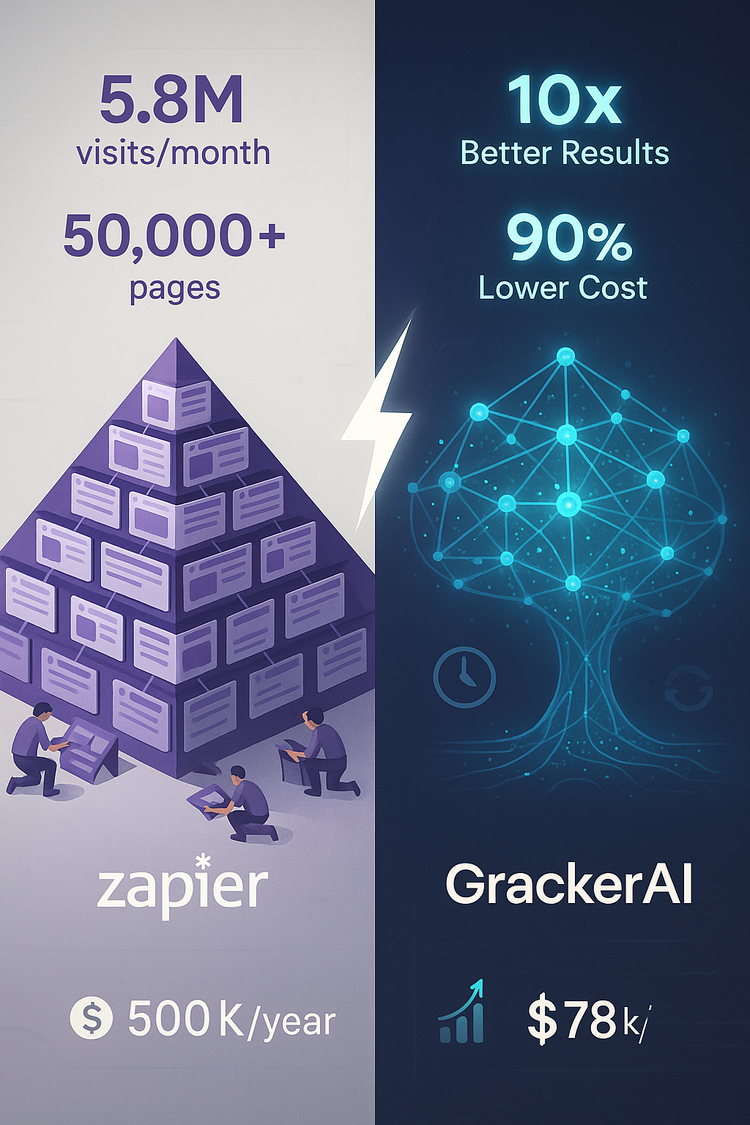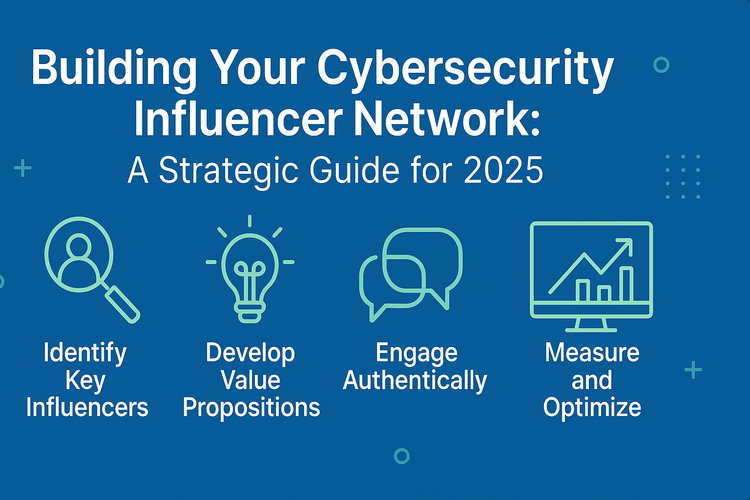Effective Strategies for Developing Cybersecurity Content That Engages Prospects
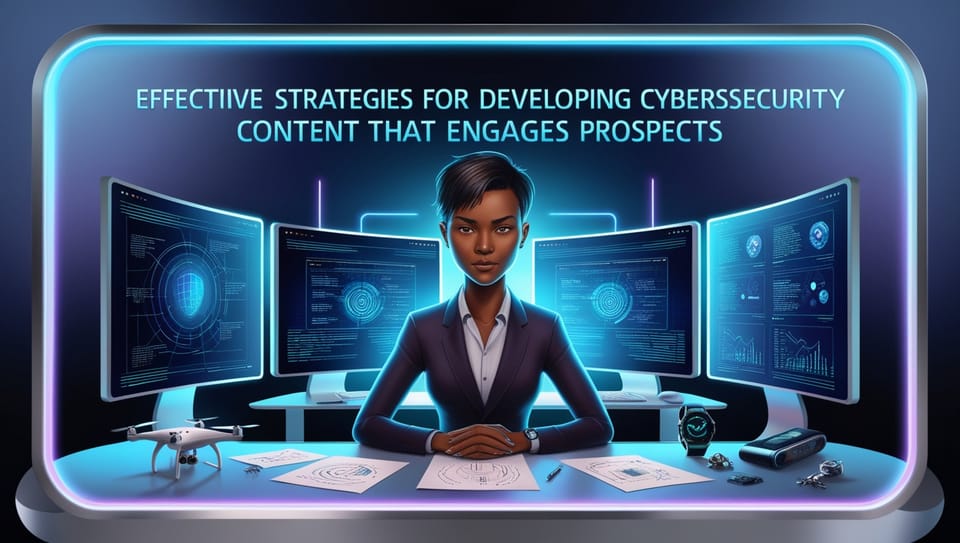
In today's digital world, capturing your target audience's attention requires content that is informative, engaging, and valuable. With around 42% of business, security, and IT leaders reporting a rise in cyber breaches since 2020, more companies are looking for cybersecurity solutions. To stand out, your cybersecurity website needs content that not only gets found but also converts visitors into customers.
Image Alt tag: content for cybersecurity
By mastering the creation of effective content for your cybersecurity site, you can reach a wider audience at a time when cyber threats are more prevalent than ever. Before we explore key considerations for content creation, it’s important to understand the two main types of content commonly used in cybersecurity marketing.
What kind of content can be used in cybersecurity marketing?
In cybersecurity marketing, content typically falls into two main types: educational content and promotional content. Both serve different purposes but are crucial for attracting and converting customers.
1. Educational Content:
-
Blog posts and articles: These provide insights into the latest cybersecurity trends, threats, and best practices.
-
White Papers and eBooks: In-depth resources on complex cybersecurity topics, helping to build credibility.
-
Case studies: Show how your solutions have solved real-world cybersecurity problems for other clients.
-
Videos and webinars: Offer tutorials, demos, or interviews with industry experts.
-
Infographics: Visual explanations of complex security issues or statistics that are easy to digest.
2. Promotional Content:
-
Product pages: Highlight the features and benefits of your cybersecurity products or services.
-
Customer testimonials: Build trust by showing the positive experiences of other users.
-
Landing pages: Focus on converting visitors by offering free demos, consultations, or trial services.
-
Email campaigns: Provide personalized promotions or updates on new services or security alerts.
Both types should be used strategically to educate potential customers and drive them toward choosing your solutions.
6 Things to Consider for Effective Strategies for Cybersecurity Content
Creating engaging and effective cybersecurity content requires careful planning. Here are seven key things to consider when developing your cybersecurity content strategy:
1. Utilising Analytics Tools
Analytics tools, such as marketing automation platforms, play a key role in tracking website performance, user behaviour, and optimizing content. Tools like Google Analytics are widely used to monitor website traffic and user engagement, while heatmap tools like Hotjar show how visitors interact with your site, highlighting areas of interest and opportunities for improvement.
Regularly updating your content based on these insights helps ensure it stays relevant and engaging.
2. Creating Engaging and Educational Content
The core of successful cybersecurity marketing lies in producing engaging, educational content that resonates with potential customers. At the top of the funnel, educational content helps build trust and credibility by demonstrating your expertise in the field. Consistently delivering high-quality content is essential for driving organic traffic and enhancing brand visibility.
Focusing on topics that matter to your prospects not only sets you apart in the competitive cybersecurity space but also makes it easier for buyers to confidently evaluate and choose the right vendor. Great content is the key to achieving growth in cybersecurity marketing, as it effectively addresses the specific needs and concerns of your audience.
Utilizing a variety of content formats, such as blogs, infographics, and videos, helps simplify complex cybersecurity concepts, making them more accessible. Educational webinars, comprehensive whitepapers, and case studies are particularly valuable at the middle-of-the-funnel stage, providing in-depth insights that further engage prospects and guide them towards making informed decisions.
Key Elements of Effective Cybersecurity Marketing Content
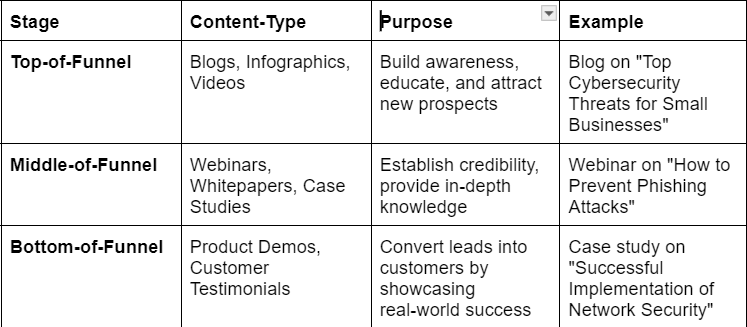
By offering a mix of engaging content tailored to each stage of the buyer’s journey, businesses can effectively attract, engage, and convert prospects in the cybersecurity industry.
3. Crafting Informative Blog Post
Creating informative blog posts that focus on specific cybersecurity threats and provide actionable prevention tips is crucial for successful content marketing. A captivating headline draws the audience in, while breaking down complex concepts into clear, easy-to-understand language makes the content more accessible.
Incorporating real-world scenarios and storytelling helps make technical topics more relatable, and using visuals like charts or infographics can enhance understanding by illustrating key ideas and breaking up lengthy text.
4. Building Trust through case studies and Testimonials
In cybersecurity marketing, trust is one of the most critical factors when converting prospects into customers. Case studies and testimonials are highly effective content strategies for building this trust, as they provide tangible proof of your expertise and success in solving real-world cybersecurity challenges.
How Case Studies Build Trust
A case study offers a detailed narrative of how your product or service helped a client overcome specific cybersecurity issues. It highlights the problem, the solution you provided, and the positive results achieved. By showcasing actual outcomes, case studies help potential customers see the value of your solution in action.
- Key elements of a successful case study:
-
Client background: Brief overview of the company and its cybersecurity needs.
-
The challenge: Specific security threat or problem faced by the client.
-
The solution: Steps or strategies your business implemented to solve the issue.
-
Results: Quantifiable outcomes such as reduced data breaches, improved security posture, or increased compliance.
How Testimonials Build Credibility
Testimonials from satisfied clients offer third-party validation, which enhances your company’s credibility. These direct quotes from customers highlight their positive experiences, reinforcing trust and confidence in your services. When prospects see that others have benefitted from your cybersecurity solutions, they are more likely to trust and consider your offerings.
-
Best practices for testimonials:
-
Keep them authentic and specific.
-
Include the client’s name, title, and company for added legitimacy.
-
Use video testimonials when possible to make the content more personal and impactful.
Using Case Studies and Testimonials Effectively

Benefits of Case Studies and Testimonials for Cybersecurity Content:
-
Builds trust: Both case studies and testimonials offer proof that your services work, providing a level of assurance to new prospects.
-
Shows credibility: Featuring well-known or respected clients in your industry boosts your authority.
-
Engages prospects: Real-world stories are more engaging than promotional materials, helping to nurture leads through the buyer's journey.
By incorporating these elements into your cybersecurity content strategy, you can create a powerful trust-building narrative that resonates with potential clients, ultimately increasing conversions and customer loyalty.
5. Designing Eye-Catching Infographics
Infographics are a powerful tool for simplifying complex cybersecurity topics, making them easier to understand for a wide audience. When done well, they are visually appealing, informative, and highly shareable, allowing your content to reach a broader audience. In the cybersecurity industry, where the subject matter can be technical and challenging to grasp, infographics provide an opportunity to communicate key messages in an engaging and digestible format.
Why Use Infographics in Cybersecurity Content?
-
Simplifying Complex Topics: Cybersecurity often involves technical jargon and intricate processes that can overwhelm readers. Infographics break down these concepts into simple, easy-to-understand visuals. For example, an infographic on the “Lifecycle of a Cyber Attack” can visually map out each phase of an attack, making it more relatable.
-
Improving Engagement: People are more likely to retain information presented visually. Infographics help capture attention quickly and convey key points more effectively than text-heavy content. This is especially valuable when trying to explain cybersecurity protocols, threat detection, or prevention strategies.
-
Increasing Shareability: Infographics are highly shareable on social media and other platforms, allowing your cybersecurity content to reach a wider audience. A well-designed infographic on “Top Cybersecurity Threats in 2024” could be shared by industry professionals and prospects alike, increasing your brand’s visibility.
Key Elements of Effective Infographics for Cybersecurity
Best Practices for Cybersecurity Infographics:
-
Focus on a Single Concept: Don’t try to cover too much in one infographic. Stick to one topic, like “Types of Cybersecurity Attacks” or “How to Protect Your Business from Data Breaches.”
-
Use Visual Hierarchy: Ensure the most important information stands out with larger fonts, bold colors, or prominent placement on the graphic.
-
Incorporate Real Data: Use statistics and figures from trusted sources to support your points, making the infographic more credible.
-
Optimize for Sharing: Design the infographic in a format that’s easy to share across social media platforms and websites. Use high-quality images and make sure the file size is optimized for fast loading times.
Advantages of Using Infographics in Cybersecurity Content:
-
Enhanced Understanding: Makes complex cybersecurity topics easier to comprehend.
-
Higher Engagement: Visuals attract more attention and hold interest longer than text.
-
Increased Shareability: Easily shared across social media and other platforms, expanding your reach.
-
Boosts SEO: Infographics can generate backlinks and drive traffic to your website when properly optimized.
By incorporating eye-catching infographics into your cybersecurity content strategy, you can simplify difficult topics, engage your audience more effectively, and increase your reach. This ultimately helps in building trust with your audience while educating them about critical cybersecurity issues.
6. Producing In-depth Whitepapers
Whitepapers are a highly effective tool in cybersecurity marketing, offering detailed analysis and expert insights on specific issues. They provide valuable information on topics like threat prevention, compliance, and emerging technologies, positioning your business as an industry thought leader. White Papers typically target mid- to bottom-of-funnel prospects, providing the depth needed to make informed decisions.
Key Elements of Cyber Security White Papers
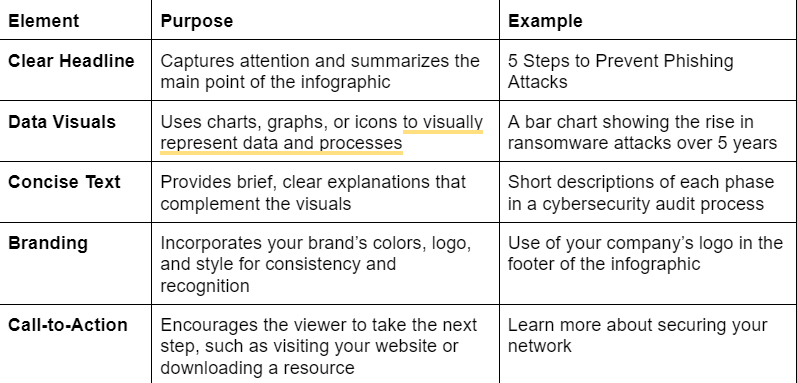
In-depth whitepapers help build credibility, generate leads, and provide solutions to complex cybersecurity challenges.
Conclusion
Developing effective cybersecurity content requires a strategic approach that combines educational and promotional elements. By utilizing analytics tools, creating engaging content, building trust through case studies and testimonials, designing eye-catching infographics, and producing in-depth whitepapers, you can effectively attract, educate, and convert potential customers in the competitive cybersecurity market.s


